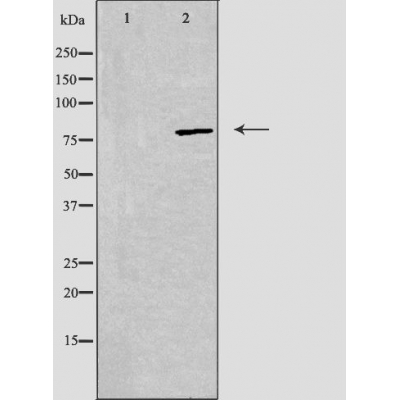ADD2 Antibody - #DF3509
| Product: | ADD2 Antibody |
| Catalog: | DF3509 |
| Description: | Rabbit polyclonal antibody to ADD2 |
| Application: | WB IF/ICC |
| Reactivity: | Human, Mouse, Rat |
| Prediction: | Pig, Zebrafish, Bovine, Horse, Sheep, Rabbit, Dog, Xenopus |
| Mol.Wt.: | 81 KD; 81kD(Calculated). |
| Uniprot: | P35612 |
| RRID: | AB_2835871 |
Product Info
*The optimal dilutions should be determined by the end user. For optimal experimental results, antibody reuse is not recommended.
*Tips:
WB: For western blot detection of denatured protein samples. IHC: For immunohistochemical detection of paraffin sections (IHC-p) or frozen sections (IHC-f) of tissue samples. IF/ICC: For immunofluorescence detection of cell samples. ELISA(peptide): For ELISA detection of antigenic peptide.
Cite Format: Affinity Biosciences Cat# DF3509, RRID:AB_2835871.
Fold/Unfold
ADD1; ADD2; ADD3; ADDA; ADDB; ADDL; Adducin 1 (alpha); Adducin 1; Adducin 2 (beta); Adducin 2; Adducin 3 (gamma); Adducin 3; Adducin like; Alpha adducin; Beta adducin;
Immunogens
A synthesized peptide derived from human ADD2, corresponding to a region within the internal amino acids.
Expressed mainly in brain, spleen, kidney cortex and medulla, and heart. Also expressed in human umbilical vein endothelial cells, human vascular smooth muscle cells, kidney tubular cells and K-562 cell line.
- P35612 ADDB_HUMAN:
- Protein BLAST With
- NCBI/
- ExPASy/
- Uniprot
MSEETVPEAASPPPPQGQPYFDRFSEDDPEYMRLRNRAADLRQDFNLMEQKKRVTMILQSPSFREELEGLIQEQMKKGNNSSNIWALRQIADFMASTSHAVFPTSSMNVSMMTPINDLHTADSLNLAKGERLMRCKISSVYRLLDLYGWAQLSDTYVTLRVSKEQDHFLISPKGVSCSEVTASSLIKVNILGEVVEKGSSCFPVDTTGFCLHSAIYAARPDVRCIIHLHTPATAAVSAMKWGLLPVSHNALLVGDMAYYDFNGEMEQEADRINLQKCLGPTCKILVLRNHGVVALGDTVEEAFYKIFHLQAACEIQVSALSSAGGVENLILLEQEKHRPHEVGSVQWAGSTFGPMQKSRLGEHEFEALMRMLDNLGYRTGYTYRHPFVQEKTKHKSEVEIPATVTAFVFEEDGAPVPALRQHAQKQQKEKTRWLNTPNTYLRVNVADEVQRSMGSPRPKTTWMKADEVEKSSSGMPIRIENPNQFVPLYTDPQEVLEMRNKIREQNRQDVKSAGPQSQLLASVIAEKSRSPSTESQLMSKGDEDTKDDSEETVPNPFSQLTDQELEEYKKEVERKKLELDGEKETAPEEPGSPAKSAPASPVQSPAKEAETKSPLVSPSKSLEEGTKKTETSKAATTEPETTQPEGVVVNGREEEQTAEEILSKGLSQMTTSADTDVDTSKDKTESVTSGPMSPEGSPSKSPSKKKKKFRTPSFLKKSKKKEKVES
Predictions
Score>80(red) has high confidence and is suggested to be used for WB detection. *The prediction model is mainly based on the alignment of immunogen sequences, the results are for reference only, not as the basis of quality assurance.
High(score>80) Medium(80>score>50) Low(score<50) No confidence
Research Backgrounds
Membrane-cytoskeleton-associated protein that promotes the assembly of the spectrin-actin network. Binds to the erythrocyte membrane receptor SLC2A1/GLUT1 and may therefore provide a link between the spectrin cytoskeleton to the plasma membrane. Binds to calmodulin. Calmodulin binds preferentially to the beta subunit.
The N-terminus is blocked.
Cytoplasm>Cytoskeleton. Cell membrane>Peripheral membrane protein>Cytoplasmic side.
Expressed mainly in brain, spleen, kidney cortex and medulla, and heart. Also expressed in human umbilical vein endothelial cells, human vascular smooth muscle cells, kidney tubular cells and K-562 cell line.
Each subunit is comprised of three regions: a NH2-terminal protease-resistant globular head region, a short connecting subdomain, and a protease-sensitive tail region.
Belongs to the aldolase class II family. Adducin subfamily.
Restrictive clause
Affinity Biosciences tests all products strictly. Citations are provided as a resource for additional applications that have not been validated by Affinity Biosciences. Please choose the appropriate format for each application and consult Materials and Methods sections for additional details about the use of any product in these publications.
For Research Use Only.
Not for use in diagnostic or therapeutic procedures. Not for resale. Not for distribution without written consent. Affinity Biosciences will not be held responsible for patent infringement or other violations that may occur with the use of our products. Affinity Biosciences, Affinity Biosciences Logo and all other trademarks are the property of Affinity Biosciences LTD.
